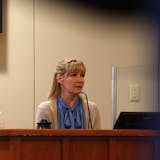Piles and piles of wood waste, some more than 30 feet tall, are stacked near the Mississippi River in St. Paul.
The heaps are growing and they’re not the only ones in the metro, and a struggle is on to get rid of the debris.
The emerald ash borer infestation and recent storms have left the metro area with too much wood, and few options for disposing of it.
The problem
The metro area generates about 550,000 tons of wood waste annually, a figure expected to grow in the coming years, according to Jon Klapperich, wood-waste specialist for the Minnesota Pollution Control Agency.
“The volume is so great that there are no good choices,” said Rep. Rick Hansen, DFL-South St. Paul, who chairs the House environment and natural resources committee.
And this wood could spontaneously catch fire, especially given the current drought conditions, experts warn.
Ben Cooper, general manager of Rainbow Treecare, said that this year, the state will reach peak infestation levels of the ash borer, leading to an increase in ash tree removals.
“We’re at this kind of breaking point or tipping point,” Cooper said. “Unfortunately, one of the consequences is that the prices to get rid of debris have gone up, like fourfold in some cases, just this year.”



